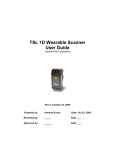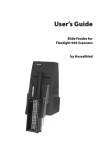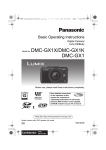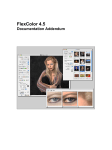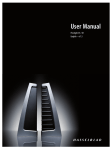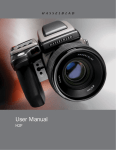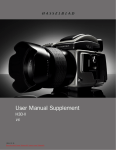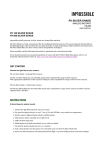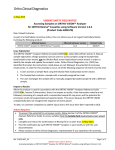Download HM 16-32 Film Magazine User Manual
Transcript
USER MANUALS FILM MAGAZINE HM 16-32 Item no.: 3033016 LCD panel HM 16-32 Film Magazine A The HM 16-32 film magazine is a sophisticated semi-independent unit within the modular H-system. It has its own power supply for individual information storage, LCD panel, illumination, etc. B Much information is transmitted and received between the magazine and the camera body, so ensure the databus connection is kept clean and not damaged in any way. It is advisable to fit the magazine protective cover when storing a film magazine to protect both the databus connection and the darkslide. LCD illumination button The features include: • Automatic120/220compatibility • Automaticwindon/windoff • Automaticfilmadvance • LCDinformationpanel • Integraldarkslide • Customizabledataimprinting • IlluminatedLCD A The various functions are accessed by repeatedly pressing the function selector button (loop menu) and changes made by the ‘change-up’ and ‘change-down’ buttons. Any settings are automatically saved. At very low temperatures the LCD will require a few seconds to display new settings. C D B The LCD can be illuminated by pressing the display illumination button, which is accessible when the magazine is not attached to the camera. The LCD will remain illuminated all the time you keep thebuttondepressed,uptoamaximumof10seconds.After10 seconds has expired, you must release the pressure on the button andpressagaintoobtainafurther10secondperiodofillumination. Remember that using the illumination function very often will noticeably shorten the life of the battery in the magazine. When the magazine is attached to the camera, the button on the magazine is inaccessible but you can still illuminate the LCD by pressing the illumination button on the grip instead. Change up button • Barcoderecognition • Count-uporcount-downfilmframereminderchoice • Multishotoption F E C Can change the settings ‘upwards’. For example, to increase the film speed setting. Toggle action. Change down button D Can change the settings ‘downwards’. For example, to decrease the film speed setting. Toggle action. Function selector A F G H B I J K G L H E Selects the four functions that can be set on the magazine. The functions are on a menu loop so that repeated pressing of the selectorbuttonwillsuccessivelyaccessallfunctionsinturn.Aftera time-out of five seconds of non-activity, the display returns to the main screen. Film plane index C D F Provides a measuring point for the actual position of the film plane in the magazine. Used for calculations in critical applications. E Darkslide key G Withdraws and replaces the darkslide. Fold out the key and turn it counter-clockwise360°(towardstheopen symbol) to withdraw itandclockwise360°(towardstheclosed symbol) to replace it. Darkslide indicator Note Parts and components A. I LCD panel G. B. LCD illumination button H. Darkslide indicator C. Change up button I. Film tab holder D. Change down button J. Film holder key E. Function selector K. Magazine settings lock F. Film plane index L. Databus interface J Changes can only be made when the settings lock switch is in the unlocked position. Darkslide key Film tab holder Note 3 L K J 4 1 Operation If you attempt to make an exposure when the darkslide is closed, however, you will receive a warning message in the viewfinder and grip LCDs – ‘The darkslide is closed’. 3, 4 Removal Ensure that the darkslide indicator on the magazine shows red (signifying that the darkslide is closed). Firstly push the lever of the magazinereleasebuttontotheright(fig.4/1)andwhilemaintaining that position press the centre of the button firmly inwards towardsthecamerabody(fig.4/2)tofinallyreleasethemagazine. 2 Battery The magazine uses a battery to retain information and settings when unattached from the camera. When attached to the camera body,themagazinetakesitspowerrequirementsfromthecamerabatteries.Themagazinebatterywillnormallybeeffectivefor 1-2yearsdependingonuse(offcameraillumination,forexample). When the battery is in a very low condition, (approx. 1 month of use left), a low-battery symbol appears on the magazine LCD as a warning. The magazine will continue to function with no battery power left as long as it remains attached to the camera body. However, when detached, the settings will not be stored. Battery replacement 2 = exposure CAN be made (magazine cannot be removed from camera) You can attach and remove the magazine with or without the film holder in place. If you just want to change to a new film, you can remove and reload the film holder without having to remove the whole magazine. L Data interface between magazine and camera. Ensure the contacts are kept clean and protected from damage. Keep the protective cover on when the magazine is being stored or transported. 1 (magazine can be removed from camera) ok ! Attachment Position the magazine retention groove onto the magazine support on the camera body ensuring that they are correctly positioned. Swing the magazine towards the camera body and firmly press into place with a click. If there is resistance, the magazine retaining catch on the camera has probably been inadvertently released. In that case, push the release button again to reset the catch. K Allsettingscanbelockedtoavoidinadvertentchanges.Tochange the settings, slide the settings lock (see illus) to the right until it stops.Afterthechangeshavebeenmade,slidethesettingslockto the left (see symbol on magazine) again to secure the new settings. Databus interface stop ! = exposure CANNOT be made You cannot remove a magazine from the camera body if the magazine darkslide is not in place, (when the magazine darkslide indicator on the magazine shows white). Neither can you withdraw the magazine darkslide when the magazine is not attached to the camera. Both these restrictions therefore prevent accidental film loss caused by fogging. Secures the film holder in the magazine. Fold out the key and turn counter-clockwise 90° to remove the film holder and turn clockwise90˚tolockthefilmholderinplace. Magazine settings lock = Attaching and removing the magazine I Holds an ID tab from the film roll pack as a reminder of the type of film loaded. Don’t forget to change it if you change film type! Film holder key RED WHITE = The darkslide can only be withdrawn when the magazine is attached to the camera. H Indicates whether the darkslide is in place or withdrawn: 1, 2 Release the film holder by folding out the film holder key and rotatingit90°inacounter-clockwisedirection.Withdrawthe film holder completely. On the bottom plate on the inside of the film magazine housing you will find a slotted circular battery cover. Insert a small coin or similar into the slot and rotate the coverabout20°inacounter-clockwisedirection.Thecoverwill be freed and the battery can be removed. Replace with a fresh CR2032/3Vlithium(orequivalent)battery.Observethepolarity and ensure the positive (+) face is uppermost and replace the cover (ensure the retaining lugs are inserted in the battery compartment slots), locking it into place by rotating it in a clockwise direction until it stops. If you inadvertently insert the battery incorrectly, the film magazine will not be damaged though it will not function. Try to avoid touching the surface of the battery with your bare fingers as sweat residue can decrease the electrical conductivity of the battery casing and might cause corrosion. Note Note If the film holder is inadvertently removed mid-film, then exposed frames will naturally be lost due to light fogging. However, if the film holder is re-inserted, the film will automatically be advanced by three frames to position fresh unexposed film. The film counter will also correspondingly add on three frames to the original number recorded before the film holder was removed. You cannot remove a magazine if the darkslide is not closed. Note Film settings (ISO / film length) are automatic only if the magazine is set at Barcode automatic. That is, a barcoded film cannot override a manual film speed setting but a manual setting can override the film speed of a barcoded film. Note Films without a barcode must have their speed set manually. A manual setting must also be made if you want to override the speed setting of a barcoded film. After battery replacement, the magazine’s parameters return to thedefaultsettings(Barcode,120,Data-on,Countup). 1/2 Note Ensure you press on the centre of the button, not on the lever. www.hasselblad.com Film magazine HM 16-32 – 3033016 – 2011 – v1 USER MANUALS FILM MAGAZINE HM 16-32 Item no.: 3033016 Magazine settings Press the function selector ( access: Frame counter setting button ) repeatedly to successively A. Filmspeed(ISO/BarCode) C A B. Filmlength(120/220/Numberofframes) D. Framecounter(countdown/countup) D E. Low-battery warning symbol E 1 2 4 3 220filmlength setting. Manual film speed setting. C. Data(on/off) B Film speed setting / Barcode To access frame counter setting: The film speed (ISO / ASA) can be set automatically or manually. AutomaticsettingusesaBarcode(onlysomefilmshavethisfeature, notably Fujifilm). This is the default setting. 1) Ensure the magazine settings lock is in the unlocked position. 2) Press the button until Remain appears. 3) Press either the button or the button to reach the desired setting (toggle function). •‘on’willshowthenumberofframesremainingontheroll. •‘oFF’willshowthenumberofthenextframeintheseries. 4) The new setting will be saved automatically after a time out of five seconds. 5) Return the magazine settings lock to the locked position. To access Manual setting: Data imprinting setting. 1) Ensure the magazine settings lock is in the unlocked position. 2) Press the button until a figure (or barcode symbol) appears together with ISO. 3) Press either the or the button to reach the required setting. 4) The new setting will be saved automatically after a time out of five seconds. 5) Return the LCD settings lock to the locked position. EXAMPLE ‘Frames remaining’ counter setting. Note Operation and changes made to the data imprinting function are accessed through the camera menu. Please see separate section in camera User Manual for full details. Film length/number of frames Both 120 and 220 films can be used. 120 film will produce 8 (for usewith‘half-length’120filmsonly)or16framesand220filmwill produce 32 frames. The low-battery symbol only appears on the magazine LCD when the battery needs changing. In the example shown here: If, however, the film has no barcode then proceed as follows: Film speed Low-battery symbol Example If the film has a barcode, then film length setting (and film speed setting) is automatic. The LCD will automatically show the barcode symbol and the appropriate film length. (Note that film speed can be overridden with barcoded films, but not film length). 5 The frame counter can be set to show either how many unexposed frames remain on a film or how many frames have already been exposed. The LCD shows your choice of setting by adding the word Remain as a reminder of the number of frames remaining or ‘countdown’. Absence of this word implies the opposite, namely, ‘count-up’, so it denotes the number of the next frame to be used (for example, the figure 4 means three frames have already been exposed). This information is also automatically displayed on the grip LCD and viewfinder LCD though only as a figure above a symbol. To access film type setting: Film length 1) Ensure the magazine settings lock is in the unlocked position. 2) Press the button until the 120 or 220 symbol appears. 3) Press either the or the button to change the desired setting. 4) The new setting will be saved automatically after timeout. 5) Return the magazine settings lock to the locked position. Data Frame counter • 120filmlengthsetmanually • thefilmspeed(ISO160)hasbeensetmanually • 5frameshavealreadybeenexposed(thereforewithregular 120 film, 11 frames remain) • thebatteryisfunctional Data imprint setting Data imprinting can be activated or deactivated through the magazine menu. To access data setting: Note If you use both standard and barcoded films (or overridden barcoded films), check that you have changed the settings accordingly. 1) 2) 3) 4) Ensure the magazine settings lock is in the unlocked position. Press the button until the Data symbol appears. Press either the or the button to reach On or Off. The new setting will be saved automatically after a time out of five seconds. 5) Return the magazine settings lock to the locked position. Film loading 1 2 1 2 4 3 5 1 Thefilmmagazinecanbeloadedeitheronoroffthecamera.Regularly check the interior of the magazine and remove dust, particles or any scraps of paper from previous rolls of film. Load and unload film magazines away from direct light sources. FRA 1) Fold out the film holder key and turn it counter-clockwise 90°. Withdraw the film holder completely. 2) Place an empty take-up spool in the upper spool holder by placing one end over the fixed stud in the holder and the other end underneath the sprung spool retaining arm. Rotate the spool a little if necessary until it clicks into position. 3) Completely remove the retaining paper band from a new roll of film and place it in the lower spool holder. See diagram for correct orientation. Ensure you do not place the film spool the wrong way around! 4) Pull 8–10 cm (3–4 in.) of paper backing from the film roll and insert the tongue of the backing paper into the slot in the take-up spool. Turn the spool one complete turn to ensure the tongue is firmly held in place by the overlying paper backing. 5) Re-insert the film holder into the main body of the film magazine ensuring the correct orientation. Press firmly inwards towards the magazine and pay particular attention to see that both sides are level with the magazine body before turning the film holder key clockwise 90˚ to lock the film holder in place and fold the key back into its stored position. You might find that increased pressure on the left hand side of the film holder will more easily ensure a positive and correct positioning in the magazine. If the camera is active or in standby mode the film will be wound automatically by the camera to position the first frame (this function can be changed in Custom Options so that the film is advanced only when the shutter release button is pressed the first time). DEU ESP ITA PRT SWE NLD 7 Hasselblad A/S. The text in this manual cannot be reprinted or reused without the express permission o Victor Hasselblad AB & Hasselblad A/S. The images in this manual cannot be reprinted or reused without the express permission o the photographers who took them. Victor Hasselblad AB & Hasselblad A/S assumes no responsibility or liability for any errors o inaccuracies that may appear in this manual. Victor Hasselblad AB & Hasselblad A/S assumes no responsibility or liability for loss or dam Este texto na sua língua? Usar “Google Translate” na Internet. Denna text på ditt språk? Använd “Google Translate”på Internet. Deze tekst in uw taal? Gebruik ‘Google Translate’ op het internet. age incurred during or as a result of using Hasselblad products. Hasselblad, Imacon, Ixpress, FlexColor and Phocus are trademarks of Victor Hasselblad A & Hasselblad A/S. Adobe, Adobe Photoshop is a trademark of Adobe Systems. Copyright © 2011 Victor Hasselblad AB & Hasselblad A/S All rights reserved. IND 6, 7 Wind on: See ‘Film wind-on’ under Custom Options for a setting choice. 6 without notice, and should not be construed as a commitment by Victor Hasselblad AB CHN The beeper sounds immediately after the last-but-one frame has beenexposed.ThisfunctioncanbeturnedoffinCustom Options. Film wind on and off The information in this manual is furnished for informational use only, is subject to chang JPN Beeper 2 Ce texte dans votre langue? Utilisez “Google Translate” sur Internet. Diesen Text in Ihrer Sprache? Verwenden Sie “Google Translate” im Internet. Este texto en su idioma? El uso de “Google Translate” en Internet. Questo testo nella tua lingua? Utilizzare ‘Google Translate’ su Internet. RUS Windoff:Whenthelastframehasbeenexposed,thefilmwillautomaticallybewoundoff.However,towindoffafilmsooner,press thefilmwindoffbutton(fig.6).Useaballpointpenorsimilarto activate it. You must also confirm the message on the grip LCD (fig. 7)beforethefilmwindsoff. Visit www.hasselblad.com to download user manuals, datasheets, product brochures, technical information, technical articles, software and firmware updates etc., as well as news about the latest developments at Hasselblad. SAU 41 Unloading a magazine To remove a film, remove the film holder in the same manner as when loading a film. Grip the exposed roll of film firmly and remove. Ensure the paper backing is wound tightly and that it is sealed with the band properly (the band may need to be moistened to activate the adhesive depending on type). Store exposed films away from strong light sources and contact with sharp objects. Move the remaining empty spool to the take-up spool compartment. Visit www.hasselblad.com to download user manuals, datasheets, product brochures, technical Ce texte dans votre langue? information, technical articles, software and firmware updates etc. as well as to read FRA about the latest Utilisez “Google Translate” sur Internet. developments at Hasselblad. Diesen Text in Ihrer Sprache? Verwenden Sie “Google Translate” im Internet. Este texto en su idioma? ESP El uso de “Google Translate” en Internet. Questo testo nella tua lingua? ITA Utilizzare ‘Google Translate’ su Internet. The information in this manual is furnished for informational use only, is subject to change without notice, and should not be construed as a commitment by Victor Hasselblad AB & Hasselblad A/S. The text and images in this manual cannot be reprinted or reused without the express permission of Victor Hasselblad AB & Hasselblad A/S. Victor Hasselblad DEU AB & Hasselblad A/S assume no responsibility or liability for any errors or inaccuracies that may appear in this manual. Victor Hasselblad AB & Hasselblad A/S assume no responsibility or liability for loss or damage incurred during or as a result of using Hasselblad products. Copyright © 2011 - Victor Hasselblad AB & Hasselblad A/S. All rights reserved. 2/2 www.hasselblad.com Film magazine HM 16-32 – 3033016 – 2011 – v1





